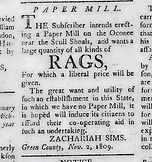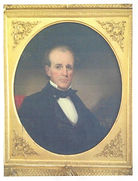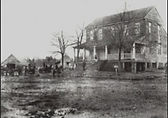top of page

VISIT........SAVE !
Georgia History

Old Village Warehouse
SCULL SHOALS HISTORY

PREHISTORY: Native American hunter/gatherers have been attracted to the fertile shoals for 10,000 years evidenced by random pottery sherds and lithic projectile points. In about 900 A.D. the Mississippian Period began with corn agriculture dominating the entire Oconee Valley.Upstream from the mill complex, Scull (Skull) Shoals mounds honored powerful priest/chiefs.Mill occupants found skeletal reamins giving rise to the spelling "SKULL Shoals" It remained a favorite hunting reserve by the visiting, often warring, Creek Nation centered along Alabama-Georgia border.
FRONTIER SETTLEMENT begins 1784 with Revolutionary War Veteran land grants near Oconee & Apalachee Rivers' frontier border (intact boundary until 1802). Hard scrabble cattle & tobacco farmers held off nature and Creek Indian attacks. In 1791, aristocratic Virginian land baron, Joel Early, (1745-1806) father of GA governor Peter Early, purchased 2917 acres from Rev. War vet Jos. Pannell then added 1060 acres and named it Fontenoy plantation.
Creek Indians Declared War on all white settlers after unjust land treaties 1780's & 90s. In two years, 82 Mid-Oconee River Valley settlers killed, and others maimed or captured in violent raids for 20 years.
-
1787 Greenesborough village ( just one year old) raided with 31 casualties.
-
April 1793 Indian raid at Scull Shoals kills six ( man, woman, 3 children & 1 slave).
-
Private & government log forts urgently needed & built. In 1793, Lt Cupp built Ft. Clarke at Scull Shoals. We are still looking for archaeological evidence. ( see artist concept)








Covered bridge courtesy Jack Wynn



1870 image of warehouse

The Invention of the Cotton Gin by Eli Whitney in 1798 forever changed the South. Thousands of Scull Shoals acres were cotton planted and harvested by hundreds of slaves. At the mill cotton ginned and woven into a coarse Osnaburg, amuslin like fabric. (shown left)
Agriculture and Antebellum Water Powered Mills
King Cotton rules the Southeast
Fontenoy : Immense Scull Shoals plantation by Virginia Planter Joel Early
First Georgia Water Powered Paper Mill
Thomas Ligon & Zachariah Sims
1807 Thos Ligon opened first Greene County cotton ginnery
1809 Ligon & Zachariah Sims oversee construction and operation of gin, grist mill, lumber mill, and covered toll bridge as Greene County population expands to 12,000 largely agricultural folks (half Black).
1810 Sims -A feisty, blacksmith and mechanical genius, seeks $4,000 in 3 yr.loan from GA legislature as 1812 War with Britain looms with high seas embargoes of paper. He receives $3,000 and advertises for rags for paper manufacture.
1811-1817 Innkeepers Geo.W. Paschal (a relative) and Agnes Paschal aided the paper effort accommodating mill visitors. She was a compassionate self taught nurse highly respected for later innkeeping and medical care in the gold rush madness of Auraria.
1811 Augusta Chronicle-
"The paper mill of Mr. Zachariah Sims, on the Oconee in Greene County, the progress of which we have heretofore noticed, is now completed, and some sheets of paper for experiment have been made.... he will proceed in the manufacture.. as soon as he can procure skillful workmen."
1814 Industrious manufacturing effects to be defeated by river water lowering drought, loan due and war over. Paschals move to manage Bowling Green Inn ( ghost town now lost north of Maxeys, GA.) catering to wealthy planters and their racehorses. After husband GW dies she moves to Auraria serving and comforting to age of ninety.
1815 Thos. Ligon takes over after Sims bankruptcy and expands textile operation by re-purposing existing structures.
Rise & Fall of SCULL SHOALS TEXTILE EMPIRE
Thomas Noel Poullain 1792-1889
Cotton Magnate
1827 Dr. Thos. N. Poullain purchased mills and 1620 acres straddling the river including Peter Early estate of 348 acres for $13,500. He relocates to Scull Shoals and is Postmaster. He is largest Greene County slave owner with 145, largely raising cotton.
1832 Dr. Poullain, two Athens men & two Wray brothers-in-law contributed $45,000 total incorporating "Skull Shoals Manufacturing Co."
1835 Factory increases to two large wooden frame structures. Advertises for 18-20 more operatives, "liberal wages and comfortable housing for families of five or more." Children welcome to contribute to production. (See the illustration of saddlebag worker house )
1830-50 The Gilded Age of Mill prominence covered in cotton
Federal protectionist tariffs against foreign goods and the enormous amount of cotton production breathed life in the fledgling Georgia textile industry. The Piedmont Oconee River drainages offered prime water to power numerous mills.In 1830 local Scull Shoals farmers harvested 12,000 bales of cotton (4,800,000 lbs). The Scull Shoals mill with 2,000 spindles and several looms at peak production consumed 4,000 bales annually. Poullain, sons and Wray family in-laws controlled the market from seed to sea, with factoring to outside planters, local planting, harvesting, and processing into muslin-like Osnaburg and warehousing in Augusta and Savannah.
Mills Cope with Periodic Natural & Wartime Events
-
1814 Drought & Low Water flow cripples paper production
-
1841 Harrison Freshet -A major flood exacerbated by erosive naive cotton farming. Oconee toll bridge washed mile downstream -rebuilt
-
1845 Disasterous Holecaust at 9 P.M. on November 5th.The voluminous lint and resinous heart pine quickly ignited to destroy the two largest buildings.$60-70,000 uninsured loss. Poullain employed workers to rebuild in four stories tall in brick over two years.
-
1850 New Dam built due to topsoil siltation raising water levels and impeding water power ditch flow.
-
1860 New Dam needed after just ten years due to intense farm runoff
-
1860 Civil War The mill operatives, largely white, joined the rebel cause halting production. Madison, GA was the closest Civil War action. Poullain, diehard slave owner voted for secession in Milledgeville capital.
-
1885-88 Krakatoa eruption in Pacific affects 70 % of World and Georgia climate for several years. Dust enhanced vivid sunsets, droughts, and choatic weather. Best crops ever.
-
1887 Severe Flood greater volume & damage than Harrison Freshet. The $8,000 bridge swept away & never rebuilt. Huge granite support column still exists mid river. 600 warehouse wheat bushels and several hundred cotton bales ruined.
-




Warehouse Remains


bottom of page